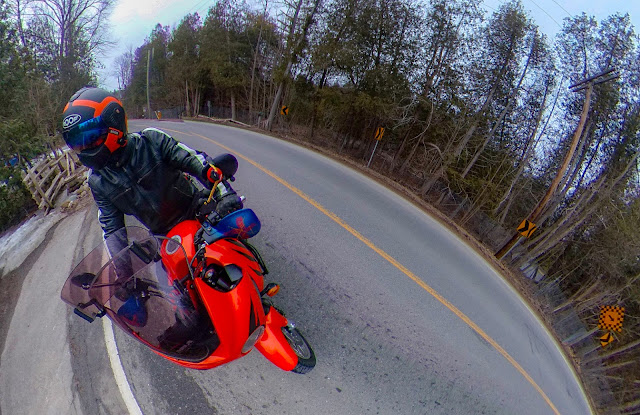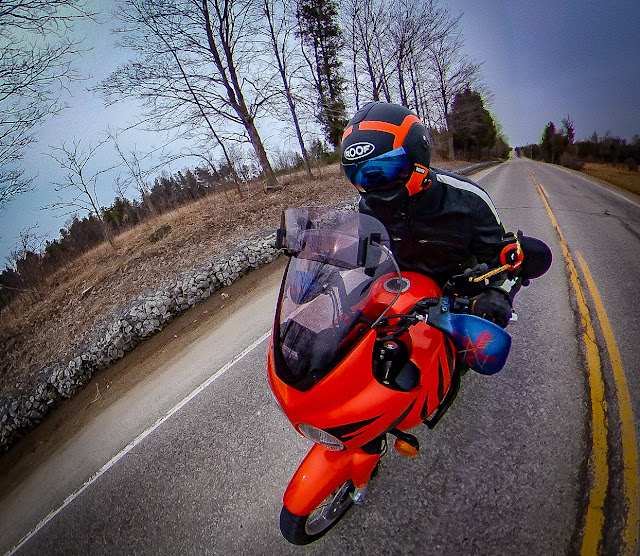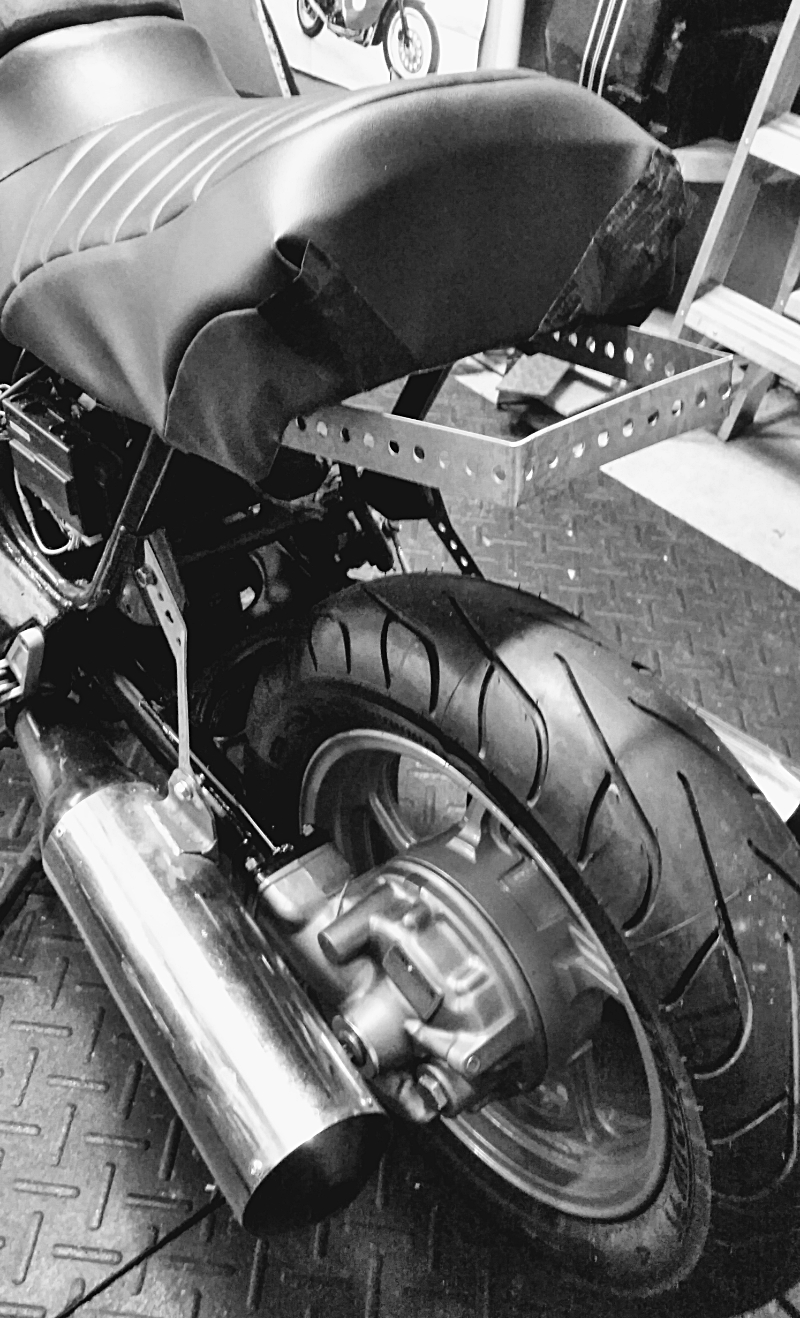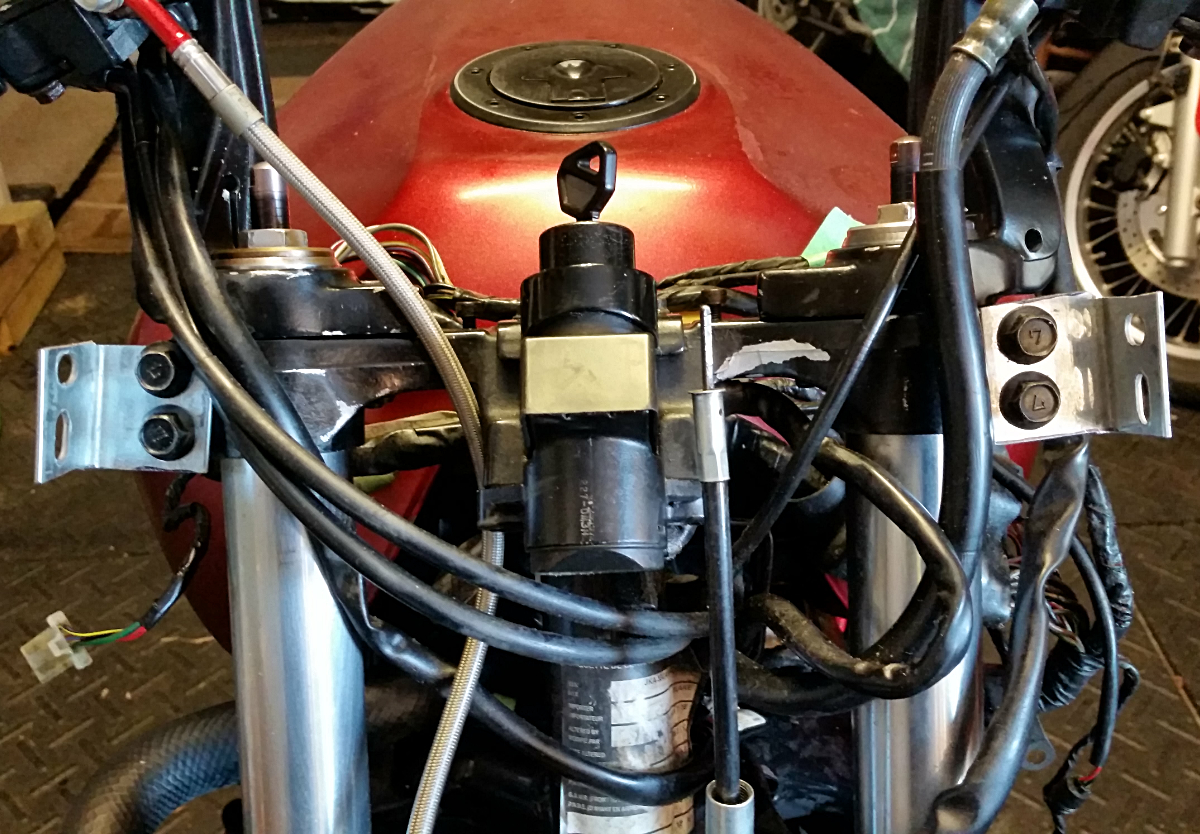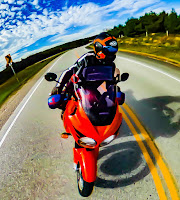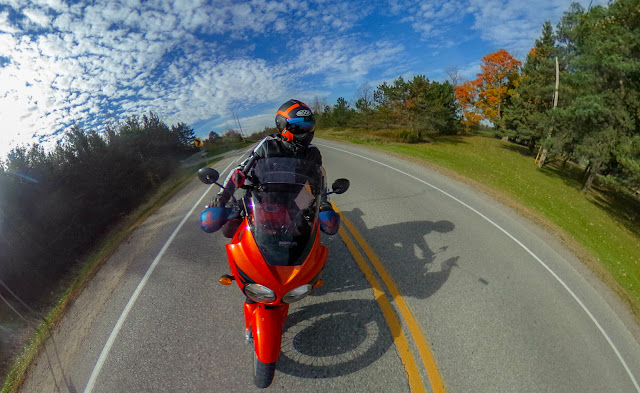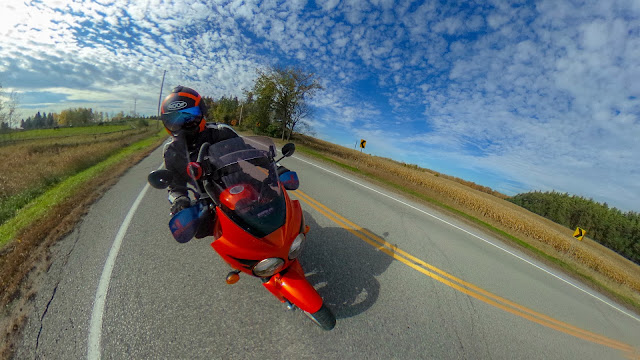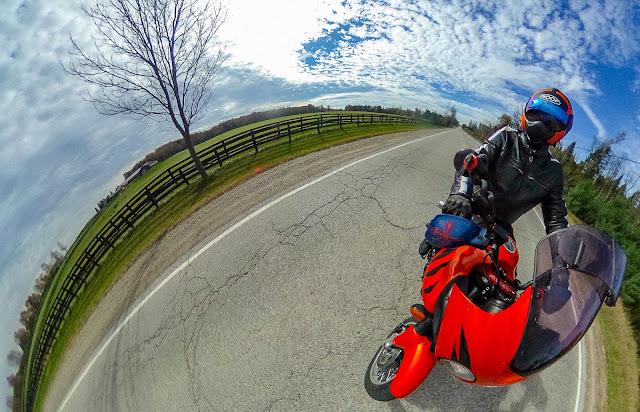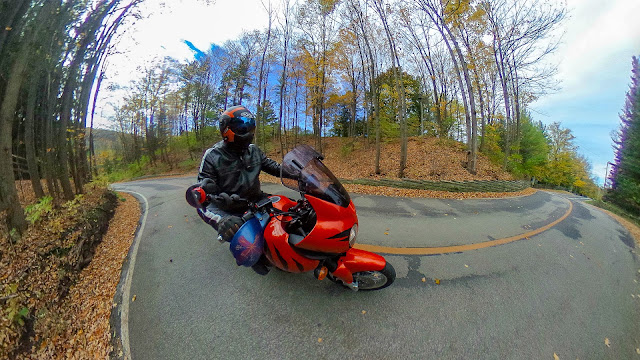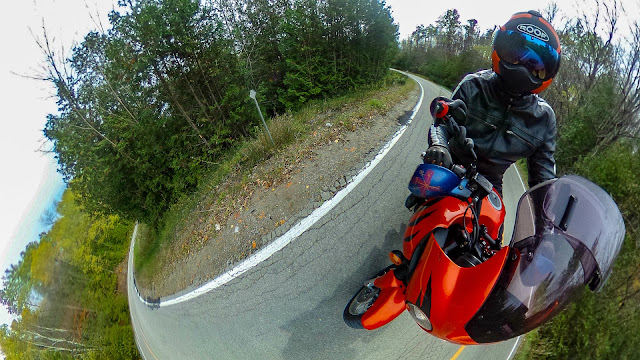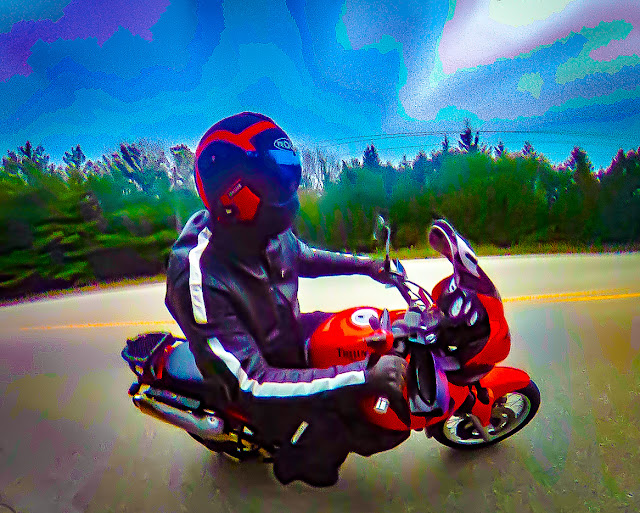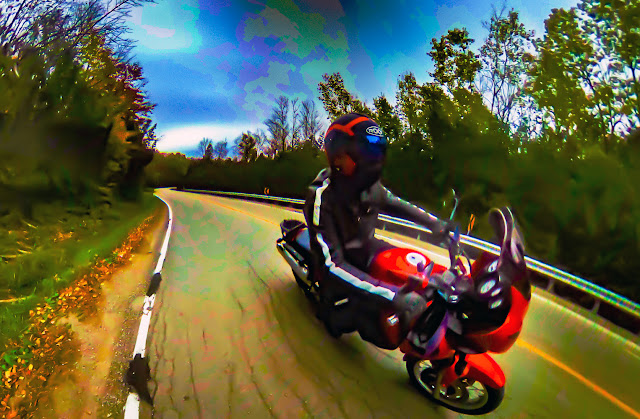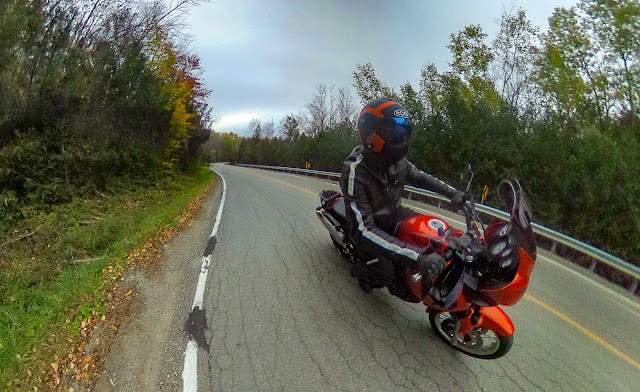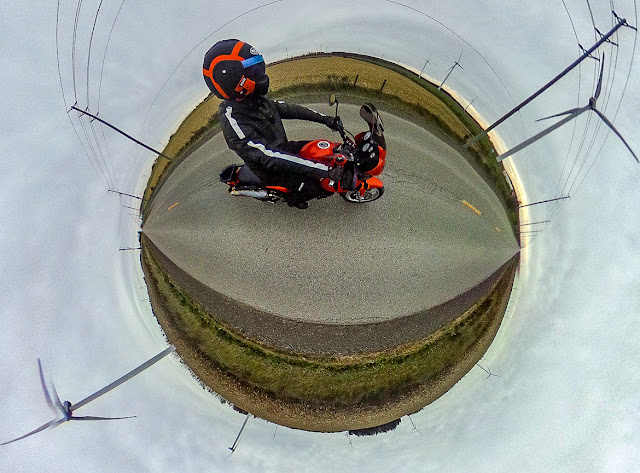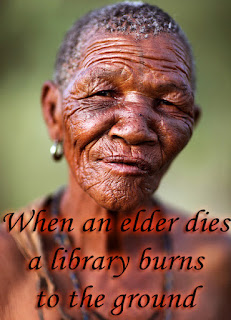
After a few days of R&R recovering from our ride out to the 1000 Islands and seeing the sights, it was time to pack up and prepare for our return home. The plan was to travel through the Halliburton Highlands, where it is claimed that Ontario’s best roads reside.
The Tiger morphed from light weight, single rider mode to two-up, full luggage touring mode in about ten minutes. The rear suspension was tightened up for the extra weight and we were ready to go.
 The plan was to cut north west from the Thousand Islands and get onto the twisties as soon as possible. It worked well. We soon found ourselves leaning into corners more than we were upright (a rarity in Ontario). When I’m in corners like that i don’t stiffen up in the saddle and I can ride for hours without fatigue.
The plan was to cut north west from the Thousand Islands and get onto the twisties as soon as possible. It worked well. We soon found ourselves leaning into corners more than we were upright (a rarity in Ontario). When I’m in corners like that i don’t stiffen up in the saddle and I can ride for hours without fatigue.
Regional Road 15 got interesting almost immediately, weaving around lakes and pieces of the Canadian Shield peaking through the earth. As we travelled north those rock outcroppings became the norm rather than the exception and the roads only got better. 38 up to Highway 7 was a lovely ride with constant bends and big elevation changes as we bounced in and out of river valleys that had cut their way through the rock. If this road was a sign of things to come, then the riding the highlands was going to be special.

We stopped at Fall River Restaurant on Highway 7 because I figured it would be the last place with a busy enough road to warrant an open business, except it didn’t. This turned into a theme on this ride: don’t depend on the tourist trade to keep a business open, instead look to a stable community to keep a business open.
The lady from the post office came out and told us only the post office is open, the general store, ice cream and restaurant are all closed and only open on the weekend. There wasn’t even a toilet available. Three vehicles pulled in looking for a stop while we were there, but were turned away. We drank our own water and stretched in the empty parking lot before hoping on the bike and continuing up the winding country road 38.

In Elphin the plan was to turn with the 38 and continue west, and even though Elphin is a tiny place with only one major turn, we missed it. This spoke to another thing we learned on this ride; you’ll see signs for corners and bumps everywhere even though these things are self evident, but navigational signs are small, missing or incorrect. I guess most people follow a screen telling them what to do nowadays, but for the rest of us, some accurate navigational signage would be appreciated.
When I saw a second sign for regional road 12 which we weren’t supposed to be on, I pulled over at the Mississippi River (when I take a wrong turn, I don’t mess around!). It was a beautiful, shady spot and we had a good stretch and watched the kingfishers getting their breakfast before saddling up again and u-turning back to Elphin.
Back on the 38 again, we wound around lakes before finding the 509 I turned left toward Ompah, but it turns out that should have been a right (turning signs around is fun!). When we arrived back at Highway 7 I just shook my head and made a right turn, figuring I could angle north again on either Kaladar or Madoc. By now the heat was back and moving at speed down Highway 7 was a nice way to cool off. This was the prettiest part of 7, with few towns and no reduced speeds, so everyone was clipping along nicely. We stopped in Kaladar for gas even though we didn’t really need it and got sports drinks. By the time we got to Madoc it was wicked hot and we sought air conditioning in the only open restaurant we’d seen so far – a McDonalds. I was beginning to despair for local food in the Highlands.
 |
Coe Hill Cafe – cool ceiling, good
bakery and coffee. |
After a much needed cool down and hydration we hopped back on the bike and hiked up highway 62 to Coe Hill, which is where we learned that you’ll find local businesses, but only in small towns where people live year round. The cottage crowd and travellers are too fickle and passing to support a business up here.
The ride up 62 had us stopping at various bridges for up to five minutes at a time due to construction, so we got into Coe Hill ready to get out of the sun for a few minutes again. Fortunately, the Coe Hill Cafe was open and got us sorted out even though we were looking a bit ragged. It’s amazing what a good cup of coffee in a cool shady place can do to get you back on your feet.
I missed the poor signage for Lower Faraday Road (the reason we’d come this way in the first place), and then missed another turn thirty seconds later. I cannot over state how random the road signage is up this way. I really wish the MoT would take the money put into redundant cornering signage and apply it to identifying the roads themselves.

They show a couple of sports bikes riding down Lower Faraday on the website, but the section they’re showing is the last mile up to Ontario 28. While this road is indeed twisty, much of the surface is atrocious with big pot holes and gravel everywhere from the many driveways that feed onto it. You’d find it frustrating trying to explore any section of this road on a sports bike.
Even with the big shocks on the Tiger it was a rough, perilous ride. You couldn’t push any corners because of the debris, quality of the road and traffic. Lower Faraday has no centre line for much of it and every vehicle coming the other way was the largest possible pickup truck you’ve ever seen moving well above the speed limit in the middle of the road, and this was on a Tuesday afternoon. We road out of our way to see this ‘ten best’ road, and it wasn’t.
 We headed in to Bancroft after the disappointing Faraday experience and stopped at the information tourism building. They have an excellent little mineral exhibit showing the various mining that goes on in the area, as well as being a cooling centre. Half an hour in the air conditioning with cold water and some cool rocks got us ready to ride again.
We headed in to Bancroft after the disappointing Faraday experience and stopped at the information tourism building. They have an excellent little mineral exhibit showing the various mining that goes on in the area, as well as being a cooling centre. Half an hour in the air conditioning with cold water and some cool rocks got us ready to ride again.
Some of the best roads of the day were ahead of us. We took 62 north out of Bancroft and then cut across toward Highland Grove. This roller-coaster of a road was well marked, clean and had a consistent surface. Corners varied from tight switchbacks to long sweepers with big elevation changes, what a joy! We followed the 648 around to the 118, passing Old Ridge Authentic BBQ (closed) where I’d hoped to have dinner.
 |
The bike looks fine, we were
exhausted! |
We quickly discovered that the 118 is no boring connecting road, with beautiful scenery and engaging corners all the way in to Haliburton. Even though it was heading towards evening the air temperature was still well in the thirties and humidity was high. We’d done over 400kms entirely on twisty back roads and were wiped. We limped in to Pinestone Resort just south of Haliburton and parked it up.
The Pinestone offered a quiet room with good beds for a reasonable price. We went for a swim (salt water indoor and outdoor pools) and then had an excellent dinner at Stone 21, the onsite restaurant. By the end of the evening we were back on our feet again.
I had us up early the next morning, hoping to beat the heat. I’d looked up good local breakfasts and found The Millpond Restaurant in Carnarvon, right on our way to Bracebridge. It was a short hop over there on very windy, but rough backroad for an excellent breakfast. Great price, great food, great service. If you’re anywhere around Haliburton, give the Millpond a go, you won’t be disappointed.
Outside afterwards the hydro line-men who were there for breakfast were curious about the bike. For the fifth time this trip I explained the resurrection of Triumph and how they are building new bikes. The general public seems to recognize the brand as historical, but our post-modern/art-deco Tiger raises a lot of questions.
It was only just past 9am at this point, we were well fed, well rested and it was a perfect 20°C under a cloudless sky. We pulled on to an empty 118 and rode the weaving, smooth pavement in bliss. No sweat, no traffic, beautiful scenery, this was the moment we’d been searching for.
 We passed through Bracebridge and got into Port Carling about 10:30am. Traffic had picked up once we were into the Muskokas, so we pulled over at the information/tourism place for a stretch and a heads up on where to get a coffee. Stopping at the info/tourism spots on this trip was never a disappointment.
We passed through Bracebridge and got into Port Carling about 10:30am. Traffic had picked up once we were into the Muskokas, so we pulled over at the information/tourism place for a stretch and a heads up on where to get a coffee. Stopping at the info/tourism spots on this trip was never a disappointment.

Port Carling is a pretty little place. We were told it was a short walk to the Camp Muskoka Coffeehouse which helps support a camp that teaches leadership to students. The coffee was excellent and the walk into town offered a good stretch.
Back up at the info-stop we bumped into a fellow from Barbados who was puzzled at our very modern looking Triumph. He said there are lots of old Triumphs on the island, but they’re very expensive. Once again I told the phoenix like story of Hinckley Triumph and how they are building some of the most modern bikes on the planet. He had no idea, but thought there would be a huge market for a modern, small Triumph (they have cc limits in Barbados). Perhaps he’ll contact Hinckley and see about the 250cc little Triumph that hasn’t happened yet.
We saddled up and left the shade of the info stop. The sun was blistering now, but we were nearing the end of our Highlands road ride. We quickly got to Bala, but I missed the poorly marked turn out to the 400 (surprise, surprise). No worries, we just stayed on the 169 down the Gravenhurst. A couple of ten minute stops at bridge construction had us both sweating heavily by the time we got into Gravenhurst. I’d only ever seen the highway side of Gravenhurst, so I was surprised that it took us 15 minutes of traffic lights to get through it.
 |
| Ahhh…. air conditioning! |
Once clear I hopped on 11 South and made time. We pushed through the heat and steady but fast moving traffic all the way past Barrie before stopping at an ONroute for gas, lunch and a cool down. I’d been getting over 49mpg solo without luggage. The astonishing Tiger was still getting 47.2mpg two up with luggage. We’d done over 430kms since our last fill up the day before in Madoc.
I used every trick in the book to cool off, soaking my head and arms to let the water evaporate and drinking a lot of fluids. We took our time before stepping back out into the oven. It was over 40°C with humidity when we finally left.
We bombed down the 400 and turned toward Orangeville on Highway 9, which was chockablock with traffic on a Wednesday afternoon. Aggressive drivers on the highway were lane changing without indicating around typically poor Canadian lane discipline (you’re supposed to pass on the left). We got cut off a couple of times, once badly enough to prompt a salute from me. On Highway 9 with eighteen wheelers spitting hot gravel at us and cars sitting at green lights while staring at their smartphones, I was at the end of my patience. We finally got around Orangeville only to almost get hit by a car passing a line of traffic coming right at us on the Fergus Road. This was as far from the 118 on a cool, quiet morning as we could possibly get.
We rolled in to Elora mid-afternoon. Once parked I pulled out the laser temperature tester from the garage. The driveway was over 50°C. A cold shower and feet up on the couch ended our 750+km ride through the Haliburton Highlands. The last leg back into Southern Ontario was the most dangerous part of the whole trip, and made me wish those sublime Ontario Highland roads weren’t so far away on the other side of these overcrowded, frustrating and tedious Southern Ontario roads.
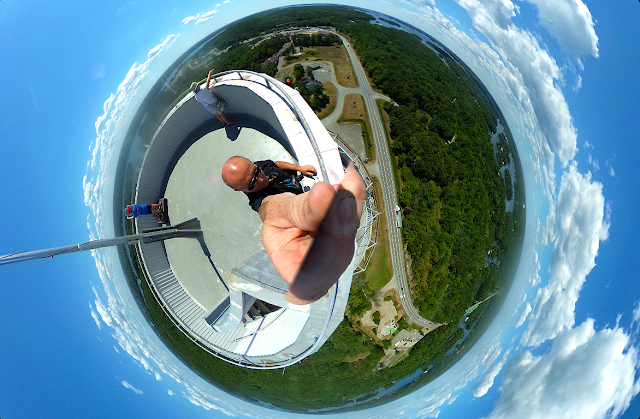 |
| Top of the tower in 1000 Islands |
 |
| Canadian rider… |
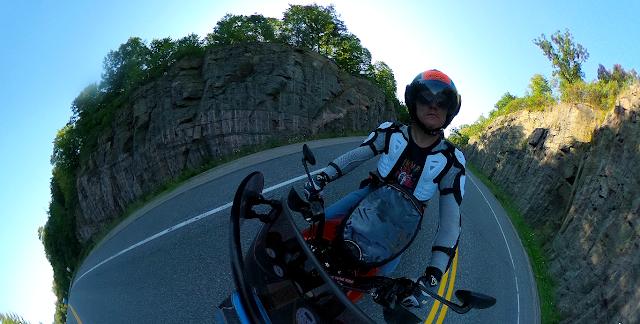 |
| Riding through the Canadian Shield… literally! |
 |
| The beginning of the big bake-off to get home |
 The other piece that I’m not feeling are my gloves. They’re sufficient (they are Joe Rocket biking specific gloves) and they are comfortable, but plain black and not particularly warm. I was aiming for a white/grey vibe when I started, the Alpinestars SP-1 gloves shown are a nice, gauntletted glove that look like they offer a much wider range of comfortable temperature options (they close up or vent as needed). They also cost four times what the beginner gloves I got cost. I imagine they are whole levels of awesomeness beyond the basic gloves I started with.
The other piece that I’m not feeling are my gloves. They’re sufficient (they are Joe Rocket biking specific gloves) and they are comfortable, but plain black and not particularly warm. I was aiming for a white/grey vibe when I started, the Alpinestars SP-1 gloves shown are a nice, gauntletted glove that look like they offer a much wider range of comfortable temperature options (they close up or vent as needed). They also cost four times what the beginner gloves I got cost. I imagine they are whole levels of awesomeness beyond the basic gloves I started with. I did the same thing with boots, I picked up the cheapest pair of bike-specific boots that were available. They are warm, dry and quite tall. I’ve always wanted an ankle boot, for cooling and the Alpinestars S-MX1 boots on the right give me the monochromatic look I’ve been looking for in a boot that isn’t huge. I purchased pretty low-rent gear to begin, mainly because what was available in the shop in the budget I was looking for. It was all purchased without any time in the saddle, so I didn’t really know what I needed, other than it should be motorbike specific.
I did the same thing with boots, I picked up the cheapest pair of bike-specific boots that were available. They are warm, dry and quite tall. I’ve always wanted an ankle boot, for cooling and the Alpinestars S-MX1 boots on the right give me the monochromatic look I’ve been looking for in a boot that isn’t huge. I purchased pretty low-rent gear to begin, mainly because what was available in the shop in the budget I was looking for. It was all purchased without any time in the saddle, so I didn’t really know what I needed, other than it should be motorbike specific.
 The pants I got (I hadn’t planned on buying pants), happened to be on sale. They’ve been great, and as early/late season pant they’re wind resistant, have a liner that would let you ride in a snow storm and have a zipper, so you could get some air going through them. They are too long and way (WAY) too hot for summer driving. Looking for well ventilated pants I could wear over shorts, these Rev’It Airwave pants fit the bill, and continue the monochromatic theme I’m looking for. A light coloured pant would also help keep the heat out.
The pants I got (I hadn’t planned on buying pants), happened to be on sale. They’ve been great, and as early/late season pant they’re wind resistant, have a liner that would let you ride in a snow storm and have a zipper, so you could get some air going through them. They are too long and way (WAY) too hot for summer driving. Looking for well ventilated pants I could wear over shorts, these Rev’It Airwave pants fit the bill, and continue the monochromatic theme I’m looking for. A light coloured pant would also help keep the heat out.
 The one piece of kit I wouldn’t want to change is the jacket I got. The Joe Rocket Atomic 11.0 textile jacket is fantastic. Great wind resistance, a removable liner, vent openings, it fits me perfectly and feels fantastic… this is a jacket for all seasons, I have no regrets with it at all. I imagine the more expensive jackets might offer lighter weight, but this particular jacket is my favorite purchase. It’s padded in all the right places and I even like the break with my monochromatic vibe. I’ve yet to find a situation where the jacket hasn’t been just what I wanted it to be.
The one piece of kit I wouldn’t want to change is the jacket I got. The Joe Rocket Atomic 11.0 textile jacket is fantastic. Great wind resistance, a removable liner, vent openings, it fits me perfectly and feels fantastic… this is a jacket for all seasons, I have no regrets with it at all. I imagine the more expensive jackets might offer lighter weight, but this particular jacket is my favorite purchase. It’s padded in all the right places and I even like the break with my monochromatic vibe. I’ve yet to find a situation where the jacket hasn’t been just what I wanted it to be. full face helmet until one day I wondered what the red button on the chin did, and suddenly it was a modular helmet that flipped up! It’s comfortable, but the wind noise isn’t ideal. I’m guessing more expensive helmets offer a tighter fit and finish meaning less wind noise. It has nice venting, and when I treat the visor with a bit of soap, it’s fog free. As a cheap first helmet, I’ve no regrets. It does more than I hoped it would and didn’t break the bank to do it. It also lets me live my inner Stig, which is never a bad thing. The built in sun visor is a nice touch too. It really is a full featured helmet. The double adjustable top and bottom vents work very well and the storm trooper vibe is cool.
full face helmet until one day I wondered what the red button on the chin did, and suddenly it was a modular helmet that flipped up! It’s comfortable, but the wind noise isn’t ideal. I’m guessing more expensive helmets offer a tighter fit and finish meaning less wind noise. It has nice venting, and when I treat the visor with a bit of soap, it’s fog free. As a cheap first helmet, I’ve no regrets. It does more than I hoped it would and didn’t break the bank to do it. It also lets me live my inner Stig, which is never a bad thing. The built in sun visor is a nice touch too. It really is a full featured helmet. The double adjustable top and bottom vents work very well and the storm trooper vibe is cool.











